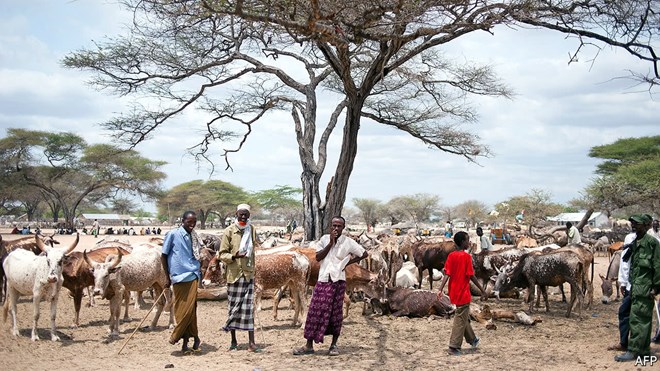By Mohamud Haj Elmi
Friday, June 05, 2020

Somali camel herders stand at a livestock market, AFP.
Drought is different from almost all other environmental hazards. It is often called a "creeping hazard" because droughts develop slowly. They also have a prolonged duration, sometimes over several years. Unlike earthquakes or floods, droughts are not confined to a particular tectonic or topographic setting; a single event can extend over regions.
Visiting Somalia in the summer of 2013 gave me a closer look at the rural population for the first time since the 1980s. When I got there, I quickly realised how hardworking the rural people were when compared to the urban population. They were eager to develop their life, but they lack the technical knowledge to cope with the huge existing climate problem facing their livelihood. The way they raise their livestock is similar as it was 100 years ago, as they rely on seasonal rain, which sometimes doesn’t come on time, hence anxiety and uncertainty of the future are their main concerns.
Recent natural disasters remind us of our society’s increasing vulnerability to the consequences of flood, drought, creating social disorder pressing down the fragile peace. One can imagine economic and technical interdependence that environmental change may have in such circumstances. Assessing the risk and uncertainty is crucial for natural hazard management, both in the evaluation of strategies to increasing resilience and facilitating risk communication for successful mitigation.
It has been estimated that as a result of natural disasters, during the 1970s and 1980s three million lives were lost worldwide, the number of disasters increased threshold and the economic losses per decade doubled with insurance losses quadrupling. In the light of these figures and in the knowledge that the technological capabilities have existed to forecast and mitigate natural hazards, the United Nations proclaimed the 1990s as the International Decade for Natural Disaster Reduction (IDNDR). The objective of IDNDR is to reduce through concert action, in developing countries, the loss of life, property damage and social and economic disruption caused by natural disasters such as earthquakes, storms, volcanoes, drought and floods
The magnitude of a disaster varies from country to country, but a prolonged drought is the most acute human tragedy causing famine, which most of the time ends in an inescapable delusion. When drought is felt in the developed nations it does not cause famine as it happens in the third world, the reason for that is because they are well prepared.
If you go to Somalia you have a different scenario, whereby a growing population with a tendency to migrate to cities, without the adequate skills to survive. This is already damaging existing urban communities and has completely disrupted the social order. How is Somalia expected to create new jobs whilst half of the population is deserting their existing jobs in the rural parts of the country?
The livestock sector, for example, is a livelihood that has not been improved for centuries and remained the same despite the emerging technology and the new way of raising livestock. The recent rapid growth in human resources has rushed to reclaim a government that relied heavily on international aid. in fact, most of the essential rural jobs which should support the bulk of the population have been deserted and discouraged by either the government itself or other people 'getting richer' without clear transparency to demonstrate the source of their wealth.
The format of the Somali economy for the last 15 years has been based largely on foreign aid and import oriented businesses instead of fostering the domestic agricultural sector and utilising arable land. Another aspect of the economy is fueled by foreign remittance sent by people living abroad. The flow of money coming into the country has reduced the economy and exacerbated high unemployment and high consumption. For example, in 2012 the UNDP estimated that the Somalia diaspora sent 1.6 billion dollars to the country. If remittances were taxed effectively during this period it could have been used to improve agriculture, infrastructure and healthcare the basic social needs of any nation.
Mohamud Hagi Elmi is a former teacher and Environmental Activist based in London, UK. He can be conatcted via [email protected]